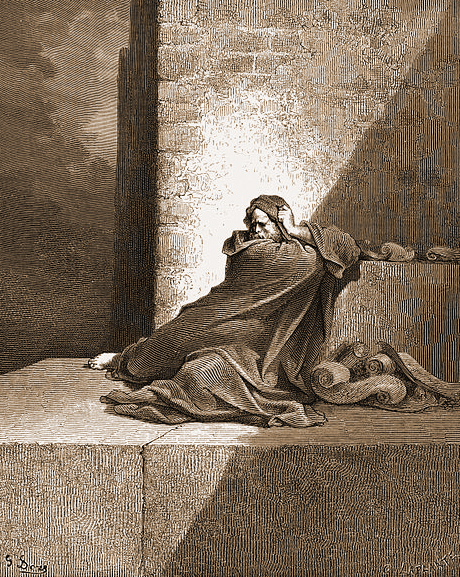Below, an abridged translation from the third volume of
Karlheinz Deschner’s Kriminalgeschichte des Christentums.
The Jewish apocalyptic
The apocalyptic genre (from the Greek apokálypsis) plays an important role, a kind of transitional role from the Old to the New Testament, especially in the epoch that goes from the 3rd century BC to the 2nd century AD.
In the apocalyptic genre one can see a kind of Jewish eschatology, so to speak, an unofficial eschatology which extends to the cosmic: beyond the official national eschatology of the rabbis. Unlike the latter, the apocalyptic literature was universalistic. It encompassed Earth, heaven and hell. However, their followers carried rather an existence of secret meetings, similar to what happens today in many sects and their relations with the churches.
As stated above, the research sees in these writings a ‘link’ between the Old and New Testaments and assigns the apocalyptic genre an intermediate period between the two. This is all the more logical because the apocalyptic authors—Jews whose exact origin (Essenes, Pharisees) is difficult to establish—are falsifiers: people who did not write under their own names but with pseudonyms; who attribute their revelations of a primordial time, from the last hour, from the beyond, its mysterious manifestations of the future, of dreams, states of ecstasy (sometimes to heaven as, among others, Enoch and also the Christian apocalyptic writer John of Patmos) to ‘visions’ while the prophets are generally based on ‘auditions’. Often, the enlightened ones who have to illuminate us are accompanied by a revealing intermediary, an angelus interpres (exegete angel) who explains to the author what happened and, of course, to us.
Typical of this sort of prayer-ridden counterfeits is their dualistic concept of the world, deeply influenced by Iranian ideas, and their theory of the two eons, one temporary and the other eternal. Typical is that the seen events are about the end of times and the ‘pains of the Messiah’ are described as imminent. All this goes from horrible human and cosmic catastrophes (women stop giving birth, the earth becomes sterile, stars collide) to the Last Judgment and a messianic splendour painted full of fantasy. Of course, the sufferings of the wicked are included, which provided a strong consolation to the righteous, together with imperious warnings of penance and conversion.
The expectation of the proximity of the end is just as typical as the hope in the hereafter and there is determinism, since ‘God has everything planned’ (4 Ezra 6): the beginning and the end. ‘This world has been created by the Highest for many, but the future only for a few’ (4 Ezra 8, 1): a novel manifestation of his Summa Misericordiae (the sum of His mercy). It is also characteristic of these intermediate testamentaries that they introduce many mysterious figures (animals, clouds, mountains) and a complicated numerical symbolism: a religious coryphaeus of earlier times in the form of Adam, Enoch, Abraham, Ezra, Moses, Isaiah, Elijah, Daniel. Theirs is an occult writing known only by a group of the elect, but now God wants to spread it.
The imposters often represent their visions of history as prophecies, in future form. Naturally, writing generally many centuries after the events and having placed their omens on their lips, they predict everything with great precision.
Their readers are amazed. So predisposed, they believe everything that they prophesied for a distant future about the horrors of the end and its magnificence. This pia fraus (loving fraud), this ‘representation of history as a vaticinium ex eventu’ (Vielhauer), has distant Old Testament parallelisms in the Pentateuch itself (Gen 49, Num 23 et seq., Deut 33) but its authentic model is, perhaps, in the oracle sibylline literature of the Hellenistic-Roman era.
 In addition to the biblical falsification of the book of Daniel that we have already seen, there is also the book of Baruch [left: Gustave Doré’s illustration], presumably written by Baruch ben Neriah: the scribe, companion and friend of the prophet Jeremiah.
In addition to the biblical falsification of the book of Daniel that we have already seen, there is also the book of Baruch [left: Gustave Doré’s illustration], presumably written by Baruch ben Neriah: the scribe, companion and friend of the prophet Jeremiah.
‘Baruch’, who appears as a messenger of God and experiences a multitude of visions, claims to have written his own book in Babylon, after the destruction of Jerusalem. He also says he knows and means much more than the prophets; and still in 1931 the Lexikonfür Theologie und Kirche did not ‘see any reason to doubt the authorship of Baruch’.
Today there are very few who claim the authenticity for this work of the Old Testament (as well as the book of ‘Daniel’) insofar as it was written half a millennium after Baruch: the first part perhaps in the 1st century BC (the farthest moment), the second part probably in the middle of the 1st century AD.
The forgeries almost always emerged as an internal necessity of the apocalyptic genre. They were widely used by the Christians and became typical of them. The easy way was simply to believe in the ‘works’ of ancient authorities—those of the twelve patriarchs; Daniel and Enoch, whose authenticity already Origen doubted, as well as the ‘works’ of Abraham, Moses, Isaiah and Ezra; in total a list of twenty names—, as their ‘prophecies’ and ‘revelations’ were being ‘fulfilled’.
______ 卐 ______
Liked it? Take a second to support this site.